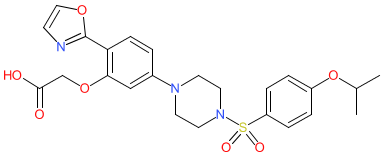GtoPdb is requesting financial support from commercial users. Please see our sustainability page for more information.
|
Synonyms: BGE-175 | BGE175 | example II-74 [US8153793B2] | S-555739
Compound class:
Synthetic organic
Comment: Asapiprant (S-555739) is a DP1 receptor antagonist that was developed for anti-inflammatory potential [2]. It has been used in an animal model of COVID-19 to indicate that targeting the PLA2G2D-PGD2/DP1 receptor pathway provides some benefit in protecting aged mice from lethal virus infection [3]. A clinical study in a select subset of human COVID-19 patients is underway (as of April 2022).
Ligand Activity Visualisation ChartsThese are box plot that provide a unique visualisation, summarising all the activity data for a ligand taken from ChEMBL and GtoPdb across multiple targets and species. Click on a plot to see the median, interquartile range, low and high data points. A value of zero indicates that no data are available. A separate chart is created for each target, and where possible the algorithm tries to merge ChEMBL and GtoPdb targets by matching them on name and UniProt accession, for each available species. However, please note that inconsistency in naming of targets may lead to data for the same target being reported across multiple charts. ✖ |
|
|||||||||||||||||||||||||||||||||||
| References |
|
1. Kugimiya A, Fujioka M, Tachibana Y, Murashi T. (2012)
Sulfonamide derivative having PGD2 receptor antagonistic activity. Patent number: US8153793B2. Assignee: Shionogi and Co Ltd. Priority date: 27/09/2005. Publication date: 10/04/2012. |
|
2. Takahashi G, Asanuma F, Suzuki N, Hattori M, Sakamoto S, Kugimiya A, Tomita Y, Kuwajima G, Abraham WM, Deguchi M et al.. (2015)
Effect of the potent and selective DP1 receptor antagonist, asapiprant (S-555739), in animal models of allergic rhinitis and allergic asthma. Eur J Pharmacol, 765: 15-23. [PMID:26277322] |
|
3. Wong LR, Zheng J, Wilhelmsen K, Li K, Ortiz ME, Schnicker NJ, Thurman A, Pezzulo AA, Szachowicz PJ, Li P et al.. (2022)
Eicosanoid signalling blockade protects middle-aged mice from severe COVID-19. Nature, 605 (7908): 146-151. [PMID:35314834] |








